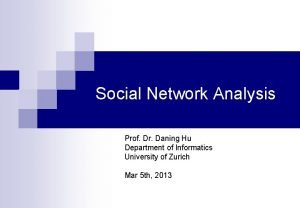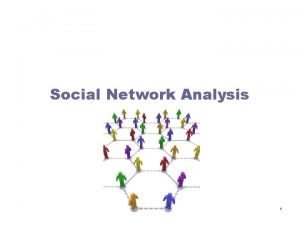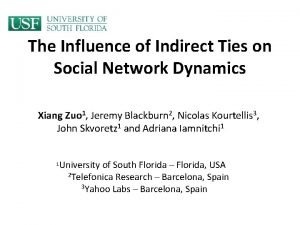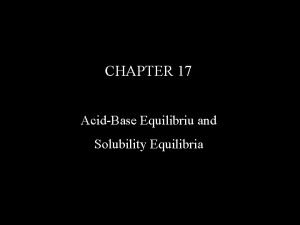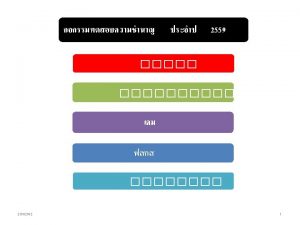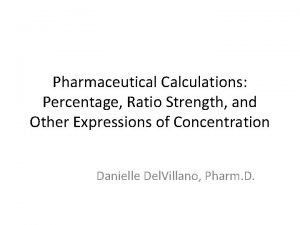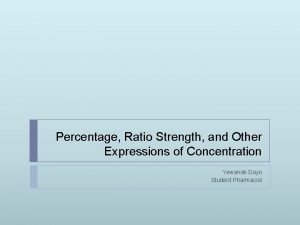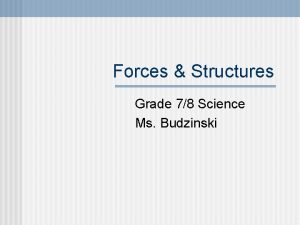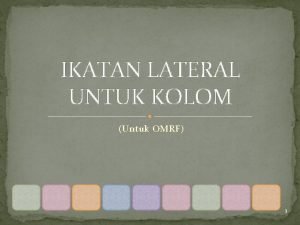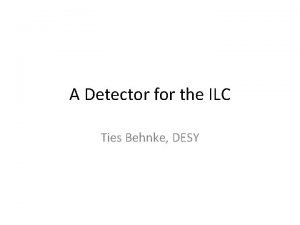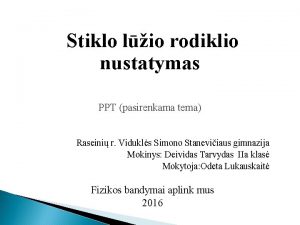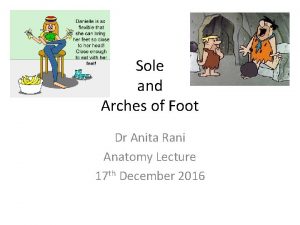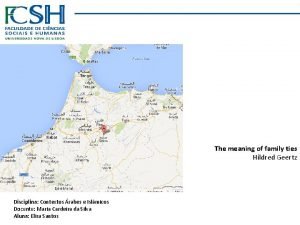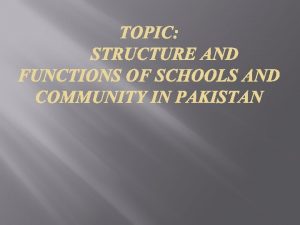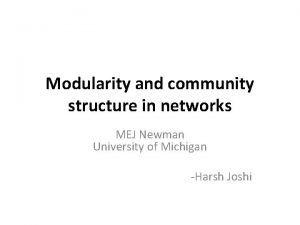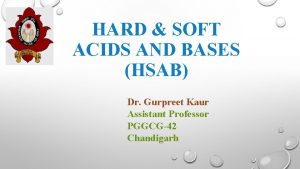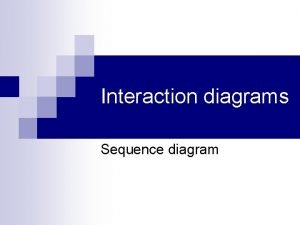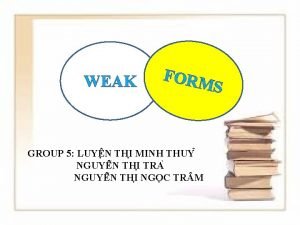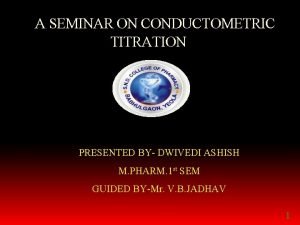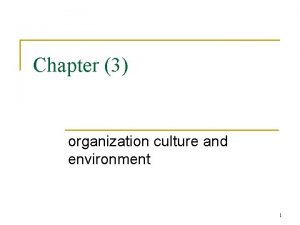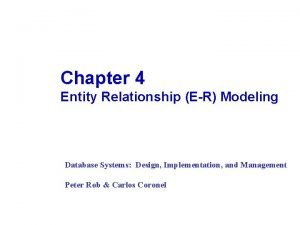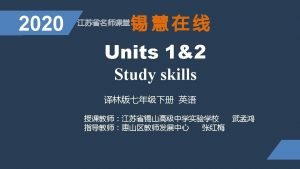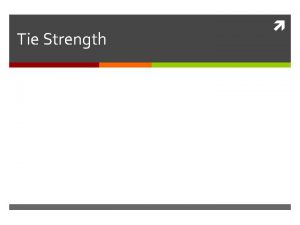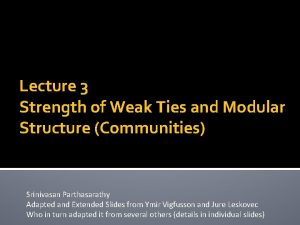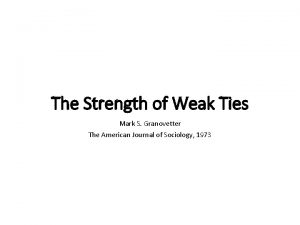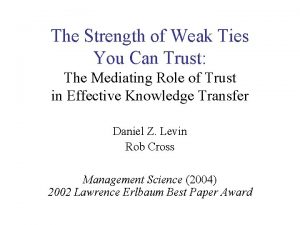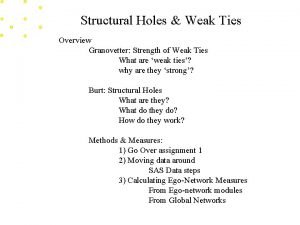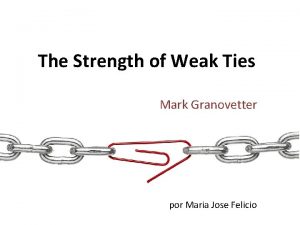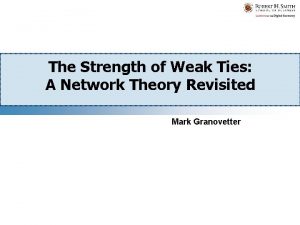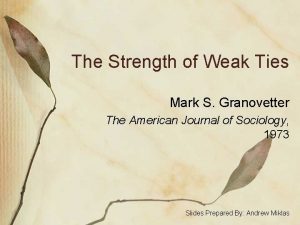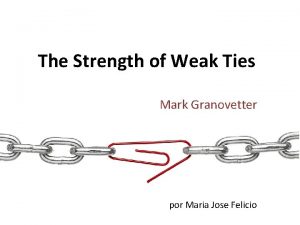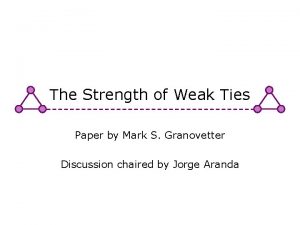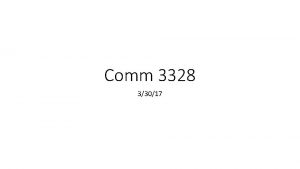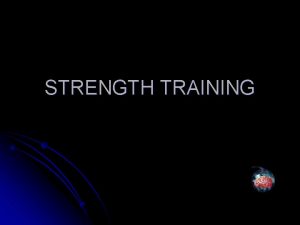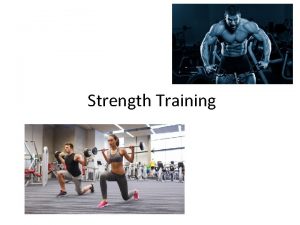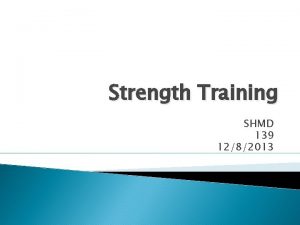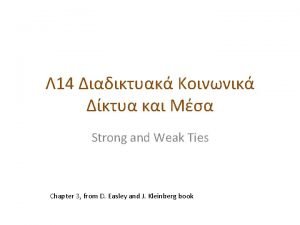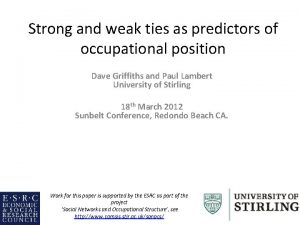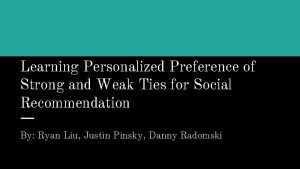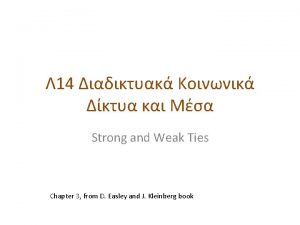Strength of Weak Ties and Community Structure in


![Strength of Weak Ties [Granovetter ‘ 73] �How people find out about new jobs? Strength of Weak Ties [Granovetter ‘ 73] �How people find out about new jobs?](https://slidetodoc.com/presentation_image/e7ab63c818c7cecbe8aaebf747517f5d/image-3.jpg)
![Granovetter’s Answer [Granovetter ‘ 73] �Two perspectives on friendships: § Structural: § Friendships span Granovetter’s Answer [Granovetter ‘ 73] �Two perspectives on friendships: § Structural: § Friendships span](https://slidetodoc.com/presentation_image/e7ab63c818c7cecbe8aaebf747517f5d/image-4.jpg)















![Structural Holes: Network Constraint �The “network constraint” measure [Burt]: § To what extent are Structural Holes: Network Constraint �The “network constraint” measure [Burt]: § To what extent are](https://slidetodoc.com/presentation_image/e7ab63c818c7cecbe8aaebf747517f5d/image-20.jpg)


![Diversity & Development [Eagle-Macy, 2010] �Measure of diversity: § ≈ 1 -ci § structural Diversity & Development [Eagle-Macy, 2010] �Measure of diversity: § ≈ 1 -ci § structural](https://slidetodoc.com/presentation_image/e7ab63c818c7cecbe8aaebf747517f5d/image-23.jpg)





![[Backstrom et al. KDD ‘ 06] Group Formation in Networks �In a social network [Backstrom et al. KDD ‘ 06] Group Formation in Networks �In a social network](https://slidetodoc.com/presentation_image/e7ab63c818c7cecbe8aaebf747517f5d/image-29.jpg)

![[Backstrom et al. KDD ‘ 06] P(join) vs. # friends in the group Live. [Backstrom et al. KDD ‘ 06] P(join) vs. # friends in the group Live.](https://slidetodoc.com/presentation_image/e7ab63c818c7cecbe8aaebf747517f5d/image-31.jpg)

![Connectedness of Friends [Backstrom et al. KDD ‘ 06] �Competing sociological theories: § Information Connectedness of Friends [Backstrom et al. KDD ‘ 06] �Competing sociological theories: § Information](https://slidetodoc.com/presentation_image/e7ab63c818c7cecbe8aaebf747517f5d/image-33.jpg)

![So, This Means That [Backstrom et al. KDD ‘ 06] �A person is more So, This Means That [Backstrom et al. KDD ‘ 06] �A person is more](https://slidetodoc.com/presentation_image/e7ab63c818c7cecbe8aaebf747517f5d/image-35.jpg)


![Method 1: Girvan-Newman [Girvan-Newman ‘ 02] �Divisive hierarchical clustering based on the notion of Method 1: Girvan-Newman [Girvan-Newman ‘ 02] �Divisive hierarchical clustering based on the notion of](https://slidetodoc.com/presentation_image/e7ab63c818c7cecbe8aaebf747517f5d/image-38.jpg)











- Slides: 49

Strength of Weak Ties and Community Structure in Networks CS 224 W: Social and Information Network Analysis Jure Leskovec, Stanford University http: //cs 224 w. stanford. edu

Join with the next slide. Networks: Flow of Information �How information flows through the network? �How different nodes play structurally distinct roles in this process? �How different links (short range vs. long range) play different roles in diffusion? 10/7/2020 Jure Leskovec, Stanford CS 224 W: Social and Information Network Analysis, http: //cs 224 w. stanford. edu 2
![Strength of Weak Ties Granovetter 73 How people find out about new jobs Strength of Weak Ties [Granovetter ‘ 73] �How people find out about new jobs?](https://slidetodoc.com/presentation_image/e7ab63c818c7cecbe8aaebf747517f5d/image-3.jpg)
Strength of Weak Ties [Granovetter ‘ 73] �How people find out about new jobs? § Mark Granovetter, part of his Ph. D in 1960 s § People find the information through personal contacts �But: Contacts were often acquaintances rather than close friends § This is surprising: § One would expect your friends to help you out more than casual acquaintances when you are between the jobs �Why is it that distance acquaintances are most helpful? 10/7/2020 Jure Leskovec, Stanford CS 224 W: Social and Information Network Analysis, http: //cs 224 w. stanford. edu 3
![Granovetters Answer Granovetter 73 Two perspectives on friendships Structural Friendships span Granovetter’s Answer [Granovetter ‘ 73] �Two perspectives on friendships: § Structural: § Friendships span](https://slidetodoc.com/presentation_image/e7ab63c818c7cecbe8aaebf747517f5d/image-4.jpg)
Granovetter’s Answer [Granovetter ‘ 73] �Two perspectives on friendships: § Structural: § Friendships span different portions of the network § Interpersonal: § Friendship between two people is either strong or weak 10/7/2020 Jure Leskovec, Stanford CS 224 W: Social and Information Network Analysis, http: //cs 224 w. stanford. edu 4

Triadic Closure �Which edge is more likely a-b or a-c? a b c � Triadic closure: If two people in a network have a friend in common there is an increased likelihood they will become friends themselves 10/7/2020 Jure Leskovec, Stanford CS 224 W: Social and Information Network Analysis, http: //cs 224 w. stanford. edu 5

Triadic Closure �Triadic closure == High clustering coefficient Reasons for triadic closure: �If B and C have a friend A in common, then: § B is more likely to meet C § (since they both spend time with A) § B and C trust each other § (since they have a friend in common) § A has incentive to bring B and C together § (as it is hard for A to maintain two disjoint relationships) �Empirical study by Bearman and Moody: § Teenage girls with low clustering coefficient are more likely to contemplate suicide 10/7/2020 Jure Leskovec, Stanford CS 224 W: Social and Information Network Analysis, http: //cs 224 w. stanford. edu 6

Have an extra slide that talks about strength of weak ties and the access to Bridge information. How does this to a information b spreading? Here we want Local to just know, bridgenot be influenced. Granovetter’s Explanation �Define: Bridge edge § If removed, it disconnects the graph �Define: Local bridge § Edge of Span>2 (i. e. , Edge not in a triangle) a b �Two types of edges: Edge: W or S § Strong (friend) and weak ties (acquaintance) S �Strong triadic closure: § Two strong ties imply a third edge �If strong triadic closure is satisfied S W S then local bridges are weak ties! 10/7/2020 S Jure Leskovec, Stanford CS 224 W: Social and Information Network Analysis, http: //cs 224 w. stanford. edu a S W S S b 7

Tie strength in real data �For many years the Granovetter’s theory was not tested �But, today we have large who-talks-to-whom graphs: § Email, Messenger, Cell phones, Facebook �Onnela et al. 2007: § Cell-phone network of 20% of country’s population § Edge strength: # phone calls 10/7/2020 Jure Leskovec, Stanford CS 224 W: Social and Information Network Analysis, http: //cs 224 w. stanford. edu 8

Neighborhood Overlap � 10/7/2020 Jure Leskovec, Stanford CS 224 W: Social and Information Network Analysis, http: //cs 224 w. stanford. edu 9

Phones: Edge Overlap vs. Strength § Highly used links have high overlap! � Legend: § Permuted strengths: Keep the network structure but randomly reassign edge strengths § Betweenness centrality: number of shortest paths going through an edge 10/7/2020 Neighborhood overlap �Cell-phone network �Observation: True Permuted strengths Betweenness centrality Edge strength (#calls) Jure Leskovec, Stanford CS 224 W: Social and Information Network Analysis, http: //cs 224 w. stanford. edu 10

Real Network, Real Tie Strengths �Real edge strengths in mobile call graph § Strong ties are more embedded (have higher overlap) 10/7/2020 Jure Leskovec, Stanford CS 224 W: Social and Information Network Analysis, http: //cs 224 w. stanford. edu 11

Real Net, Permuted Tie Strengths �Same network, same set of edge strengths but now strengths are randomly shuffled 10/7/2020 Jure Leskovec, Stanford CS 224 W: Social and Information Network Analysis, http: //cs 224 w. stanford. edu 12

Edge Betweenness Centrality b=16 b=7. 5 �Edges strength is labeled based on betweenness centrality (number of shortest paths passing through an edge) 10/7/2020 Jure Leskovec, Stanford CS 224 W: Social and Information Network Analysis, http: //cs 224 w. stanford. edu 13

Link Removal by Strength Size of largest component Low disconnects the network sooner Fraction of removed links �Removing links by strength (#calls) § Low to high § High to low 10/7/2020 Conceptual picture of network structure Jure Leskovec, Stanford CS 224 W: Social and Information Network Analysis, http: //cs 224 w. stanford. edu 14

Link Removal by Overlap Size of largest component Low disconnects the network sooner Fraction of removed links �Removing links based on overlap § Low to high § High to low 10/7/2020 Conceptual picture of network structure Jure Leskovec, Stanford CS 224 W: Social and Information Network Analysis, http: //cs 224 w. stanford. edu 15

Another Example: Facebook 10/7/2020 Jure Leskovec, Stanford CS 224 W: Social and Information Network Analysis, http: //cs 224 w. stanford. edu [Marlow et al. ‘ 09] 16

Small Detour: Structural Holes Jure Leskovec, Stanford CS 224 W: Social and Information Network Analysis, http: //cs 224 w. stanford. edu

Small Detour: Structural Holes 10/7/2020 Jure Leskovec, Stanford CS 224 W: Social and Information Network Analysis, http: //cs 224 w. stanford. edu [Ron Burt] 18

Structural Holes Few structural holes Many structural holes Structural Holes provide ego with access to novel information, power, freedom 10/7/2020 Jure Leskovec, Stanford CS 224 W: Social and Information Network Analysis, http: //cs 224 w. stanford. edu 19
![Structural Holes Network Constraint The network constraint measure Burt To what extent are Structural Holes: Network Constraint �The “network constraint” measure [Burt]: § To what extent are](https://slidetodoc.com/presentation_image/e7ab63c818c7cecbe8aaebf747517f5d/image-20.jpg)
Structural Holes: Network Constraint �The “network constraint” measure [Burt]: § To what extent are person’s contacts redundant k puv=1/du pik i pij 2 i 2 puv … prop. of u’s “energy” invested in relationship with v 10/7/2020 p 25=½ p 12=¼ j § Low: disconnected contacts § High: contacts that are close or strongly tied k 1 p =¼ 5 15 j 4 p 1 2 3 4 5 1. 00. 50 1. 0. 50. 33 2. 25. 00. 00. 33 Jure Leskovec, Stanford CS 224 W: Social and Information Network Analysis, http: //cs 224 w. stanford. edu 3. 25. 00. 00 4. 25. 00. 00. 33 5. 25. 50. 00 20

Example: Robert vs. James § Constraint: To what extent are person’s contacts redundant �Network constraint: § Low: disconnected contacts § High: contacts that are close or strongly tied § James: cj=0. 309 § Robert: cr=0. 148 10/7/2020 Jure Leskovec, Stanford CS 224 W: Social and Information Network Analysis, http: //cs 224 w. stanford. edu 21

Spanning the Holes Matters 10/7/2020 Jure Leskovec, Stanford CS 224 W: Social and Information Network Analysis, http: //cs 224 w. stanford. edu [Ron Burt] 22
![Diversity Development EagleMacy 2010 Measure of diversity 1 ci structural Diversity & Development [Eagle-Macy, 2010] �Measure of diversity: § ≈ 1 -ci § structural](https://slidetodoc.com/presentation_image/e7ab63c818c7cecbe8aaebf747517f5d/image-23.jpg)
Diversity & Development [Eagle-Macy, 2010] �Measure of diversity: § ≈ 1 -ci § structural holes + entropy of edge strengths 10/7/2020 Jure Leskovec, Stanford CS 224 W: Social and Information Network Analysis, http: //cs 224 w. stanford. edu 23

Network Communities Jure Leskovec, Stanford CS 224 W: Social and Information Network Analysis, http: //cs 224 w. stanford. edu

Network Communities �Networks of tightly connected groups �Network communities: § Sets of nodes with lots of connections inside and few to outside (the rest of the network) Communities, clusters, groups, modules 10/7/2020 Jure Leskovec, Stanford CS 224 W: Social and Information Network Analysis, http: //cs 224 w. stanford. edu 26

Finding Network Communities �How to automatically find such densely connected groups of nodes? �Ideally such automatically detected clusters would then correspond to real groups �For example: 10/7/2020 Communities, clusters, groups, modules Jure Leskovec, Stanford CS 224 W: Social and Information Network Analysis, http: //cs 224 w. stanford. edu 27

Micro-Markets in Sponsored Search query Find micro-markets by partitioning the “query x advertiser” graph: advertiser 10/7/2020 Jure Leskovec, Stanford CS 224 W: Social and Information Network Analysis, http: //cs 224 w. stanford. edu 28

Social Network Data �Zachary’s Karate club network: § Observe social ties and rivalries in a university karate club § During his observation, conflicts led the group to split § Split could be explained by a minimum cut in the network �Why would we expect such clusters to arise? 10/7/2020 Jure Leskovec, Stanford CS 224 W: Social and Information Network Analysis, http: //cs 224 w. stanford. edu 29
![Backstrom et al KDD 06 Group Formation in Networks In a social network [Backstrom et al. KDD ‘ 06] Group Formation in Networks �In a social network](https://slidetodoc.com/presentation_image/e7ab63c818c7cecbe8aaebf747517f5d/image-29.jpg)
[Backstrom et al. KDD ‘ 06] Group Formation in Networks �In a social network nodes explicitly declare group membership: § Facebook groups, Publication venue �Can think of groups as node colors �Gives insights into social dynamics: § Recruits friends? Memberships spread along edges § Doesn’t recruit? Spread randomly �What factors influence a person’s decision to join a group? 10/7/2020 Jure Leskovec, Stanford CS 224 W: Social and Information Network Analysis, http: //cs 224 w. stanford. edu 30

Group Growth as Diffusion �Analogous to diffusion Group memberships spread over the network: § Red circles represent existing group members § Yellow squares may join �Question: § How does prob. of joining a group depend on the number of friends already in the group? 10/7/2020 Jure Leskovec, Stanford CS 224 W: Social and Information Network Analysis, http: //cs 224 w. stanford. edu 31
![Backstrom et al KDD 06 Pjoin vs friends in the group Live [Backstrom et al. KDD ‘ 06] P(join) vs. # friends in the group Live.](https://slidetodoc.com/presentation_image/e7ab63c818c7cecbe8aaebf747517f5d/image-31.jpg)
[Backstrom et al. KDD ‘ 06] P(join) vs. # friends in the group Live. Journal: 1 million users 250, 000 groups DBLP: 400, 000 papers 100, 000 authors 2, 000 conferences �Diminishing returns: § Probability of joining increases with the number of friends in the group § But increases get smaller and smaller 10/7/2020 Jure Leskovec, Stanford CS 224 W: Social and Information Network Analysis, http: //cs 224 w. stanford. edu 32

Groups: More Subtle Features �Connectedness of friends: § x and y have three friends in the group § x’s friends are independent x § y’s friends are all connected y Who is more likely to join? 10/7/2020 Jure Leskovec, Stanford CS 224 W: Social and Information Network Analysis, http: //cs 224 w. stanford. edu 33
![Connectedness of Friends Backstrom et al KDD 06 Competing sociological theories Information Connectedness of Friends [Backstrom et al. KDD ‘ 06] �Competing sociological theories: § Information](https://slidetodoc.com/presentation_image/e7ab63c818c7cecbe8aaebf747517f5d/image-33.jpg)
Connectedness of Friends [Backstrom et al. KDD ‘ 06] �Competing sociological theories: § Information argument [Granovetter ‘ 73] § Social capital argument [Coleman ’ 88] x y �Information argument: § Unconnected friends give independent support �Social capital argument: § Safety/trust advantage in having friends who know each other 10/7/2020 Jure Leskovec, Stanford CS 224 W: Social and Information Network Analysis, http: //cs 224 w. stanford. edu 34

Connectedness of Friends Live. Journal: 1 million users, 250, 000 groups Social capital argument wins! Prob. of joining increases with the number of adjacent members. 10/7/2020 Jure Leskovec, Stanford CS 224 W: Social and Information Network Analysis, http: //cs 224 w. stanford. edu 35
![So This Means That Backstrom et al KDD 06 A person is more So, This Means That [Backstrom et al. KDD ‘ 06] �A person is more](https://slidetodoc.com/presentation_image/e7ab63c818c7cecbe8aaebf747517f5d/image-35.jpg)
So, This Means That [Backstrom et al. KDD ‘ 06] �A person is more likely to join a group if § she has more friends who are already in the group § friends have more connections between themselves �So, groups form clusters of tightly connected nodes 10/7/2020 Jure Leskovec, Stanford CS 224 W: Social and Information Network Analysis, http: //cs 224 w. stanford. edu 36

Community Detection How to find communities? We will work with undirected (unweighted) networks 10/7/2020 Jure Leskovec, Stanford CS 224 W: Social and Information Network Analysis, http: //cs 224 w. stanford. edu 37

Method 1: Strength of Weak Ties �Intuition: Edge strengths (call volume) in real network 10/7/2020 Edge betweenness in real network Jure Leskovec, Stanford CS 224 W: Social and Information Network Analysis, http: //cs 224 w. stanford. edu 39
![Method 1 GirvanNewman GirvanNewman 02 Divisive hierarchical clustering based on the notion of Method 1: Girvan-Newman [Girvan-Newman ‘ 02] �Divisive hierarchical clustering based on the notion of](https://slidetodoc.com/presentation_image/e7ab63c818c7cecbe8aaebf747517f5d/image-38.jpg)
Method 1: Girvan-Newman [Girvan-Newman ‘ 02] �Divisive hierarchical clustering based on the notion of edge betweenness: Number of shortest paths passing through the edge �Girvan-Newman Algorithm: § Undirected unweighted networks § Repeat until no edges are left: § Calculate betweenness of edges § Remove edges with highest betweenness § Connected components are communities § Gives a hierarchical decomposition of the network 10/7/2020 Jure Leskovec, Stanford CS 224 W: Social and Information Network Analysis, http: //cs 224 w. stanford. edu 40

Girvan-Newman: Example 1 12 33 49 Need to re-compute betweenness at every step 10/7/2020 Jure Leskovec, Stanford CS 224 W: Social and Information Network Analysis, http: //cs 224 w. stanford. edu 41

Girvan-Newman: Example Step 1: Step 3: 10/7/2020 Step 2: Hierarchical network decomposition: Jure Leskovec, Stanford CS 224 W: Social and Information Network Analysis, http: //cs 224 w. stanford. edu 42

Girvan-Newman: Results Communities in physics collaborations 10/7/2020 Jure Leskovec, Stanford CS 224 W: Social and Information Network Analysis, http: //cs 224 w. stanford. edu 43

Girvan-Newman: Results �Zachary’s Karate club: hierarchical decomposition 10/7/2020 Jure Leskovec, Stanford CS 224 W: Social and Information Network Analysis, http: //cs 224 w. stanford. edu 44

We need to resolve 2 questions 1. 2. 10/7/2020 How to compute betweenees? How to select the number of clusters? Jure Leskovec, Stanford CS 224 W: Social and Information Network Analysis, http: //cs 224 w. stanford. edu 45

How to Compute Betweenness? �Want to compute betweenness of paths starting at node A �Breath first search starting from A: 0 1 2 3 4 10/7/2020 Jure Leskovec, Stanford CS 224 W: Social and Information Network Analysis, http: //cs 224 w. stanford. edu 46

How to Compute Betweenness? �Count the number of shortest paths from A to all other nodes of the network: 10/7/2020 Jure Leskovec, Stanford CS 224 W: Social and Information Network Analysis, http: //cs 224 w. stanford. edu 47

How to Compute Betweenness? �Compute betweenness by working up the tree: If there are multiple paths count them fractionally The algorithm: • Add edge flows: -- node flow = 1+∑child edges -- split the flow up based on the parent value • Repeat the BFS procedure for each starting node 1+1 paths to H Split evenly 1+0. 5 paths to J Split 1: 2 1 path to K. Split evenly 10/7/2020 Jure Leskovec, Stanford CS 224 W: Social and Information Network Analysis, http: //cs 224 w. stanford. edu 48

Expected number of edges is wrong, could be greater than 1. Update or explain why. Motivate the null model. Take more time. How to select number of clusters? Define modularity to be Q = (number of edges within groups) – (expected number within groups) Actual number of edges between i and j is Expected number of edges between i and j is m…number of edges 10/7/2020 Jure Leskovec, Stanford CS 224 W: Social and Information Network Analysis, http: //cs 224 w. stanford. edu 50

Modularity: Definition �Q = (number of edges within groups) – (expected number within groups) �Then: m … number of edges Aij … 1 if (i, j) is edge, else 0 ki … degree of node i ci … group id of node i (a, b) … 1 if a=b, else 0 �Modularity lies in the range [− 1, 1] § It is positive if the number of edges within groups exceeds the expected number § 0. 3<Q<0. 7 means significant community structure 10/7/2020 Jure Leskovec, Stanford CS 224 W: Social and Information Network Analysis, http: //cs 224 w. stanford. edu 51

Had to rush at the end but finished the lecture almost in time. Modularity: Number of clusters �Modularity is useful for selecting the number of clusters: Q Why not optimize modularity directly? 10/7/2020 Jure Leskovec, Stanford CS 224 W: Social and Information Network Analysis, http: //cs 224 w. stanford. edu 52
 Daning hu
Daning hu Granovetter strength of weak ties
Granovetter strength of weak ties Indirect ties definition
Indirect ties definition Weak acid and weak base reaction
Weak acid and weak base reaction What are strong bases
What are strong bases Difference between strong and weak acid
Difference between strong and weak acid Yield and tensile strength
Yield and tensile strength Darrow solution half strength
Darrow solution half strength You are my strength when i am weak
You are my strength when i am weak Wish you strength
Wish you strength Ratio strength pharmacy
Ratio strength pharmacy Percent strength w/v
Percent strength w/v What is structure
What is structure Tic tie
Tic tie Electa oes star point
Electa oes star point Optimist tuning guide
Optimist tuning guide Lateral colum
Lateral colum Ties behnke
Ties behnke The dangers of soul ties
The dangers of soul ties Asf aave
Asf aave Resuscitate
Resuscitate Kodel zvejys zuvi mato auksciau negu ji yra is tikruju
Kodel zvejys zuvi mato auksciau negu ji yra is tikruju Pes cavus
Pes cavus Casual friends have strong emotional ties.
Casual friends have strong emotional ties. Relatives in islam
Relatives in islam Family ties meaning
Family ties meaning A new settlement that keeps close ties to its homeland
A new settlement that keeps close ties to its homeland Hjelp med airties
Hjelp med airties School structure definition
School structure definition Community action cycle
Community action cycle Modularity and community structure in networks
Modularity and community structure in networks Acid base strength and hardness and softness
Acid base strength and hardness and softness What are interaction diagrams
What are interaction diagrams Weak forms in sentences examples
Weak forms in sentences examples Weak syllable
Weak syllable Strong and weak semaphore
Strong and weak semaphore Theory of indicators
Theory of indicators Weak acid and conjugate base
Weak acid and conjugate base String acid
String acid Conductometric titration of strong acid and weak base
Conductometric titration of strong acid and weak base Displacement titration
Displacement titration Come unto me all who are weak
Come unto me all who are weak Weak and wounded sinner
Weak and wounded sinner Strong and weak organisational culture
Strong and weak organisational culture Weak and strong forms
Weak and strong forms Strong and weak relationship in er diagram
Strong and weak relationship in er diagram How to read a titration curve
How to read a titration curve The systematic regularity in rhythm
The systematic regularity in rhythm Stressed vowel
Stressed vowel Regiochemistry
Regiochemistry
